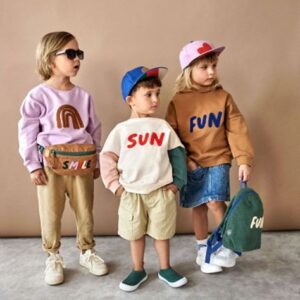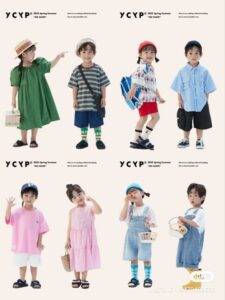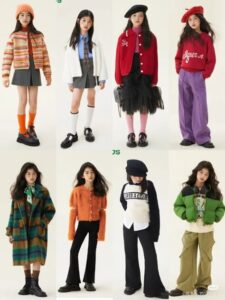Uncategorized
Why Layering is Essential in Kids’ Fashion
Layering is a fundamental aspect of kids’ fashion that combines style, comfort, and practicality. Beyond simply keeping children warm during chilly weather, layering offers versatility and creativity in dressing. It allows parents to adapt their kids’ outfits to changing weather conditions while letting kids express their unique personalities.
In this article, we’ll explore why layering is essential in kids’ fashion, share practical tips on how to do it right, and highlight some stylish layering ideas to make your little one look and feel their best.
1. The Practical Benefits of Layering in Kids’ Fashion

a. Comfort in Changing Weather
Kids are active and spend time both indoors and outdoors, often in varying temperatures. Layering ensures they remain comfortable regardless of the weather. A light sweater over a t-shirt, for example, can be removed when it gets warm, offering flexibility.
b. Easy Adaptability
Layering is especially useful during transitional seasons like spring and fall when mornings are chilly, but afternoons can be warmer. Parents can add or remove layers as needed without a complete wardrobe change.
c. Protection from the Elements
Layers act as barriers against wind, rain, and cold. Items like waterproof outer layers, soft inner layers, and cozy sweaters keep kids protected while allowing for movement and play.
d. Encourages Self-Sufficiency
Layering teaches kids about dressing independently. They can learn to put on or take off layers based on their comfort, helping them feel confident in managing their own wardrobe.
2. The Style Factor: Layering as a Fashion Statement
Layering isn’t just about practicality; it’s also a way to elevate style. When done right, it can transform a simple outfit into a trendy, eye-catching ensemble.
a. Adds Depth and Texture
Layering different fabrics and colors creates a visually interesting outfit. Pairing a chunky knit cardigan with a plaid shirt, for example, adds dimension to the look.
b. Allows for Personal Expression
With layering, kids can mix and match their favorite pieces, showcasing their personalities. Bright, bold patterns can be toned down with neutral layers, or quirky accessories can make an outfit pop.
c. Seasonal Transitions
Layering enables year-round use of favorite clothing items. A summer dress can be worn in fall with the addition of a turtleneck and leggings, maximizing wardrobe versatility.
3. Essential Layers Every Kid Needs
Building a layered wardrobe starts with versatile, high-quality basics. Here are some must-haves:
a. Base Layers
- T-Shirts and Tanks: Lightweight and breathable, these form the foundation of most layered outfits.
- Thermal Tops and Leggings: Essential for colder months, these provide warmth without bulk.
b. Mid Layers
- Sweatshirts and Hoodies: Casual and comfy, these are perfect for playtime or lounging.
- Cardigans and Sweaters: Add a touch of sophistication while keeping kids cozy.
c. Outer Layers
- Light Jackets: Denim or bomber jackets are great for spring and fall.
- Winter Coats: Thick and insulated, these are crucial for colder climates.
- Raincoats and Windbreakers: Ideal for wet or windy days, keeping kids dry and comfortable.
d. Accessories
- Scarves and Hats: Not just for warmth, these add personality to any outfit.
- Socks and Tights: Layered under shorts or dresses, they’re functional and stylish.
4. Tips for Perfect Layering

a. Focus on Comfort
Kids need to move freely, so choose soft, stretchy fabrics that won’t restrict their activities. Avoid overly bulky items that might feel heavy or cumbersome.
b. Play with Colors and Patterns
Don’t be afraid to mix and match patterns, but balance bold prints with neutral tones to avoid clashing. For example, pair a striped shirt with a solid-colored sweater.
c. Use Lightweight Layers
Opt for thin yet warm fabrics to avoid overheating. This allows for easier layering without adding too much bulk.
d. Layer by Function
- Inner Layer: Choose moisture-wicking fabrics to keep kids dry.
- Middle Layer: Focus on insulation to trap warmth.
- Outer Layer: Protect against wind and rain with weather-resistant materials.
e. Keep It Age-Appropriate
For younger kids, prioritize layers that are easy to put on and take off, such as zip-up hoodies or buttoned cardigans.
5. Creative Layering Ideas for Every Season
a. Spring
- A floral dress layered over a plain white turtleneck, paired with knee-high socks and sneakers.
- A lightweight denim jacket over a graphic tee and cotton joggers.
b. Summer
- A tank top layered with an open button-up shirt for a casual, breezy look.
- Lightweight scarves and hats for sun protection without adding too much warmth.
c. Fall
- A plaid shirt under a cozy cardigan, paired with jeans and boots.
- A hoodie layered with a quilted vest for a sporty vibe.
d. Winter
- A thermal shirt and leggings under a wool sweater and insulated coat.
- A chunky knit scarf, gloves, and a beanie to accessorize and add warmth.
6. Layering for Different Occasions

a. School
Layering offers practicality for school outfits, where kids need to transition between classrooms and outdoor recess. Pair a polo shirt with a zip-up sweater and chinos for a polished yet comfortable look.
b. Special Events
For formal occasions, layer a collared shirt under a vest or blazer. Girls can wear a tulle skirt with a cardigan over a sparkly top.
c. Outdoor Adventures
Dress kids in waterproof outer layers with fleece-lined jackets for hikes or picnics. Add thermal socks and gloves for extra warmth.
7. The Environmental and Economic Benefits of Layering
Layering extends the life of kids’ clothing by making pieces adaptable across seasons. It also reduces the need for buying season-specific items, saving money and promoting sustainability. A single dress, when layered creatively, can work for summer, fall, and winter.
Conclusion
Layering is an essential aspect of kids’ fashion that combines practicality, style, and creativity. It allows parents to prepare their children for various weather conditions and activities while giving kids the opportunity to express their individuality. By investing in versatile wardrobe staples and mastering the art of layering, you can create outfits that are functional, fashionable, and fun for every season and occasion.
So, whether it’s a crisp autumn day or a snowy winter afternoon, layering ensures your little one is ready to take on the world in comfort and style.


